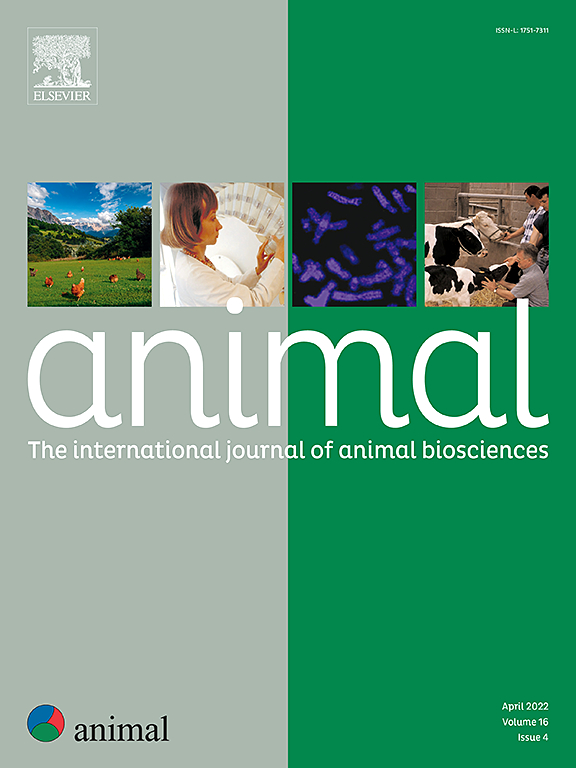Review: A systematic review of dairy cow health, welfare, and behaviour in year-round loose range housing
IF 4
2区 农林科学
Q1 AGRICULTURE, DAIRY & ANIMAL SCIENCE
引用次数: 0
Abstract
This systematic review compares the health, welfare, and behaviour of dairy cows in year-round loose housing systems against those kept in other housing systems in temperate regions. Year-round loose housing systems comprised housing where dairy cows had no access to the outdoors or only had access to a yard, pen or run. The comparator housing systems also comprised housing with and without outdoor access (including grazing). To contribute to evidence-informed policy, a systematic evidence evaluation was undertaken to assess the scientific evidence base for this question, and determine whether the evidence base is robust enough to determine any association between housing systems and health, welfare and natural behaviour in dairy cows. We assessed 11 181 references and reviewed 53 articles in detail following best practice guidance for systematic review. Seven different types of housing systems were compared and a total of 120 different Health, Welfare and Behaviour (HWB) outcomes were assessed, comprising 839 measurements for HWB. Results indicate both advantages and disadvantages of year-round loose-housing systems. These differences were not just between studies; there were also differences within-studies for individual HWB indicators. There was substantial heterogeneity in methods of collecting and measuring HWB outcomes across the studies; therefore, a robust statistical test (such as meta-analysis) of correlation between potential explanatory variables and HWB outcomes was not possible for any housing comparison or any individual HWB measurement. Assessing the evidence base systematically as a whole, there is only weak evidence that year-round loose-housing is either better or worse than housing systems with grazing for the health and welfare of dairy cows. There is also only weak evidence that year-round loose-housing is either better or worse than housing systems with any outdoor access, including but not limited to grazing, for the health and welfare of dairy cows. Variation in data reporting across studies is too great to allow robust statistical analysis of the direct effects of loose-housing systems and/or grazing on the health and welfare of dairy cows. Data are also often presented in an aggregated form that limits meaningful comparisons. For future research, data collected should be made freely available in a disaggregated form to enable robust meta-analysis to be conducted. In order to change policies and practices, based on evidence, more standardised primary research studies, measuring welfare indicators, including behaviour, are necessary.
回顾:对奶牛健康、福利和全年松散范围住房行为的系统回顾。
本系统综述比较了温带地区全年松散圈养系统中的奶牛与其他圈养系统中的奶牛的健康、福利和行为。全年松散的住房系统包括奶牛无法进入户外或只能进入院子,围栏或跑步的住房。比较国住房制度也包括有和没有室外通道(包括放牧)的住房。为了促进基于证据的政策,进行了系统的证据评估,以评估这个问题的科学证据基础,并确定证据基础是否足够强大,可以确定奶牛的住房系统与健康、福利和自然行为之间的任何关联。我们评估了11 181篇参考文献,并根据最佳实践指南详细审查了53篇文章。对七种不同类型的住房系统进行了比较,并评估了总共120种不同的健康、福利和行为(HWB)结果,包括839种HWB测量。结果表明了全年松散住房系统的优点和缺点。这些差异不仅存在于研究之间;个别HWB指标的研究内部也存在差异。研究中收集和测量HWB结果的方法存在很大的异质性;因此,对于任何住房比较或任何个体HWB测量,都不可能对潜在解释变量与HWB结果之间的相关性进行稳健的统计检验(如荟萃分析)。从整体上系统地评估证据基础,只有微弱的证据表明,为了奶牛的健康和福利,全年松散的住房系统比放牧的住房系统更好或更差。也只有微弱的证据表明,对于奶牛的健康和福利来说,全年松散的住房系统比有任何户外通道的住房系统(包括但不限于放牧)更好或更差。不同研究的数据报告差异太大,无法对松散的圈养系统和/或放牧对奶牛健康和福利的直接影响进行可靠的统计分析。数据也经常以汇总形式呈现,限制了有意义的比较。对于未来的研究,收集的数据应以分类形式免费提供,以便进行稳健的元分析。为了根据证据改变政策和做法,有必要进行更标准化的初级研究,衡量福利指标,包括行为。
本文章由计算机程序翻译,如有差异,请以英文原文为准。
求助全文
约1分钟内获得全文
求助全文
来源期刊

Animal
农林科学-奶制品与动物科学
CiteScore
7.50
自引率
2.80%
发文量
246
审稿时长
3 months
期刊介绍:
Editorial board
animal attracts the best research in animal biology and animal systems from across the spectrum of the agricultural, biomedical, and environmental sciences. It is the central element in an exciting collaboration between the British Society of Animal Science (BSAS), Institut National de la Recherche Agronomique (INRA) and the European Federation of Animal Science (EAAP) and represents a merging of three scientific journals: Animal Science; Animal Research; Reproduction, Nutrition, Development. animal publishes original cutting-edge research, ''hot'' topics and horizon-scanning reviews on animal-related aspects of the life sciences at the molecular, cellular, organ, whole animal and production system levels. The main subject areas include: breeding and genetics; nutrition; physiology and functional biology of systems; behaviour, health and welfare; farming systems, environmental impact and climate change; product quality, human health and well-being. Animal models and papers dealing with the integration of research between these topics and their impact on the environment and people are particularly welcome.
 求助内容:
求助内容: 应助结果提醒方式:
应助结果提醒方式:


